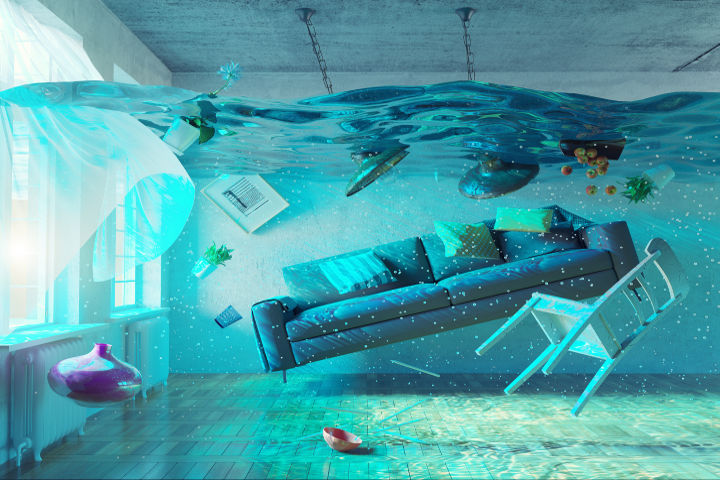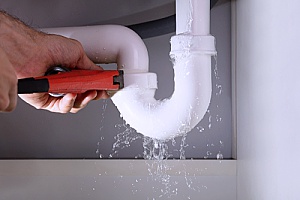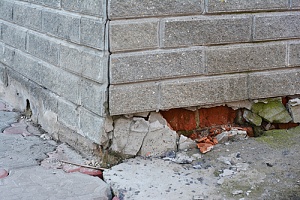
Water damage is the one most frequent type of damage a structure will suffer in its lifetime. The causes for water damage can vary. With water damage is caused by natural disasters, leaky appliances, water buildup and foundation damage. Possible repercussions of water damage are many. From unsightly stains, toxic mold and major structural damage, repairs can be expensive. No matter what type of water damage, it is always best to catch it early. The sooner you correct the water damage, the better. In order to prevent major repair expenses, you need to damage is present. This is easily accomplished by looking for any of signs included in this article.
Water Stains
One of the most obvious and common of the signs that your home suffers from water damage are water stains. Unsightly water stains can appear virtually anywhere, from walls and ceilings to around the perimeter of doors and windows. Water stains can either appear fully formed virtually overnight. They can start out as small blemishes and expand over time. Regardless of what type of stain you find, address the stain promptly.
Water stains are also one of the easiest signs of possible problems. When purchasing a new home, look for water stains. If you spot any water stains, inspect that area carefully. Ask for proof the repair was done professionally. Keep an eye out for new paint. New paint can indicate a recent repair.
Warping and Buckling
Warping or buckling walls or floors are usually a sign of more extensive damage. This type of foundation damage is found on many structures that have not received professional residential waterproofing or commercial waterproofing. As a reminder, wood or drywall can absorb moisture. Moisture absorption can cause material to expand and contract over time. This will added to additional home repairs. Obvious home repairs are just the beginning. Remember moisture breeds mold, which can be toxic. Toxic mold can damage the home and harm your family.
Corroded Pipes
A leaky pipe or faucet can usually be identified by rust and corrosion. This corrosion usually forms around the pipe joints. While inspecting your home, check the plumbing and wall surfaces for leaks. Water and moisture from leaking pipes will soak into surrounding material. The surrounding material will cause water stains. At times this moisture can cause wall covering warping. Fixing leaky pipes can range from simple replacement, to major repairs and expenses. When this occurs, be sure to hire a professional contractor.
Crumbling
Caulk and wood are two of the common materials used in home building. When water is present you can expect damage to the immediate and surrounding areas. Check areas around windows and doors. Look for water stains and or rotted material. Any molding, baseboards, drywall that show signs of water stains, indicate a possible water penetration / leak.
Smelling and Listening
Mold is one of the usual by products of water damage and moisture. When mold is present you may notice a damp and musty smell. Your nose may be the only tool you need to find water damage. Older structures have a musty smell, but the smell of mold is easily noticed. If you walk into a room and smell mold, chances are you have located the main area of your water damage.
Your nose isn’t your only organic tool in the fight against water damage. Your ears can prove to be just as invaluable. If you are sure there is a water leak somewhere, listening for the leak may be your best bet. The next time it rains, turn off every appliance in your home. Take time to listen carefully. Careful listening may help you discover the leak. The sound of it trickling water can help you locate the source of the leak.
Flashing and Insulation
Water damage causes structural damage. Make sure to check the rooms closest to the roof and foundation. Most homes, have peaked roofs. These peaked roofs need proper flashing and caulking. The flashing and caulking are vulnerable during the winter months. Melting snow and ice can trickle into these areas. Proper flashing and sealing is a must to prevent water damage.
Brittle or discolored insulation can be a sign of water damage. Pay close attention to discolored insulation, as you inspect your home for water damage. Once you locate discolored insulation, repair the immediate water entry. With the repair complete, remove and replace the damaged insulation.
Water damage can cause serious problems and expensive repairs. A proactive and preventative approach is always a good idea. Regular home inspections can help you maintain your home. Professional residential roofing or commercial roofing services are available at Dirt Connections.
Contact Dirt Connections For Professional Assistance!
Water damage can be disastrous, but in many cases it can be prevented. For more information on how our services can help prevent water damage in homes or facilities water damage and please call us directly or contact Dirt Connections online today.















































